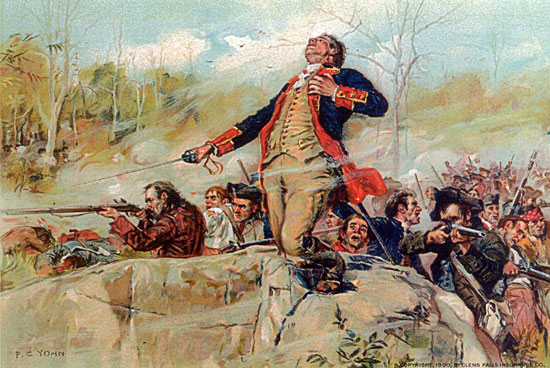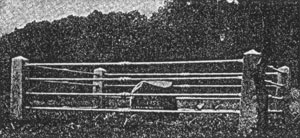| |

COLONEL EPHRAIM WILLIAMS was born in Newton, Mass., February 24th,
1715. In early life a sailor; afterward a soldier, serving as a provincial captain in
Canada during the Anglo-French War, 1740-48. In 1750 the government granted him 200
acres of hand in the present townships of Adams and
Williamstown, Mass. He commanded all the border forts west of the Connecticut
River, and in 1755 was appointed colonel of a regiment to co-operate with Sir William
Johnson in a projected campaign against Canada. With a presentiment of his early
fall, he made his will at Albany, N. Y., devising his property for the support of a free
school, which became Williams College, at Williamstown, Mass. In 1854 the alumni
of this college erected a monument on the boulder marking the spot where he fell.
THE BLOODY MORNING SCOUT.– September 8th, 1755, was a day of three
desperate and bloody battles, fought within a few miles between Glens Falls and Lake
George – important engagements, even viewed from the present. This territory, known
as the "Great Carry," a land break in the waterways of the Hudson River. Lakes George
and Champlain, and the St. Lawrence, was
strategic territory and a bloody fighting
ground for ages, probably, between Indian
war parties: all though the seventy years'
struggle between England and France for
the possession of a continent and fought to
a conclusion within this region; and afterward. during the Revolution. No part of
America is richer in historic incident and interest than the region of this natural route
between the Hudson and the St. Lawrence.

Col. Williams' Grave, Near His Monument. |
The sanguinary defeat of Braddock's
expedition against Fort Duquesne in July.
1755, gave the French, through captured
papers, information that the English were
mustering men at Albany for an expedition
against Crown Point and Canada. and Baron
Dieskau, a brave and distinguished German
officer and field marshal of France, was
promptly sent to Crown Point with 3,000
men, quite one-third veteran regulars from French battle fields. Dieskau, exemplifying
his motto, "Boldness Wins," determined on the aggressive, and believing Fort Edward
(then Fort Lyman) feebly garrisoned, he moved with a flying corps of 600 Canadians,
. as many Indians and 300 regulars against this fort. September 7th he reached the
Hudson, below Glens Falls, and learned that Sir William Johnson had already reached
Lake George with a considerable force of raw provincials. General Johnson had with
him General Lyman, Colonels Williams and Titcomb (both killed on the 8th), Seth
Pomeroy, Ruggles, the afterward Revolutionary Generals Putnam and Stark, and
King Hendrick, the famous Mohawk sachem. Dieskau, with contempt for these
untrained and inexperienced farmers, decided to make a sudden attack upon them,
and early on the 8th marched toward Lake George.
In the meantime, Johnson's
scouts reporting Dieskau's force marching on Fort Edward, dispatched Colonel
Williams with 1,000 white men and 200 Mohawks under King Hendrick to the
relief of the threatened fort. Dieskau, learning this from a captured courier, instantly
prepared to ambush them by deploying his force in a semi-circle – his Canadians on one
side of the road, his Indians on the other and his regulars in the rear – all with knapsacks
off, lying flat and hidden in the underbrush, waiting the coming of Williams. Colonel
Williams, careless for an Indian fighter of experience, proceeding without scouts or advance
skirmishers, began to enter the "trap," when Dieskau's Mohawks of the St. Lawrence,
seeing their brothers of the Mohawk Valley in Johnson's advance, gave warning by firing
in the air, when the concealed Canadians and French poured from right and left into the
surprised provincials a terrific fire, which mingled with the war whoops of the savages,
filled the ravine with "a terror of sight and sound." King Hendrick was killed and the
Mohawks retired to cover. Colonel Williams led a charge up the hill on his right to turn
the enemy's flank and secure a more commanding position, mounted a boulder (on which
his monument now stands, about six miles from Glens Falls and three miles from Lake
George) to better see and encourage his men, and fell from a bullet in his head. (See
illustration – a reduced reproduction of Mr. Yohn's sketch, owned by the Glens
Falls Insurance Company.) Surprised, being shot down by an unseen foe, deserted by
the Mohawks, their commander dead, they retreated in confusion. lieutenant-Colonel
Whiting, now in command, partially rallied the fugitives, and with the aid of 300 men
sent out from Johnson's camp, checked
Dieskau's furious pursuit, and fighting from
behind trees, in frontier fashion, covered the
retreat to Johnson's camp at Lake George.
The English loss was 216 killed and 96
wounded, including a large number of
officers. The French also suffered considerable
loss. Few prisoners were taken, for the
scalping knife and tomahawk were freely
used, and the battle field at short intervals
was in possession of either side. This is a
brief summary of what has passed into fireside story, tradition and history, as "The
Bloody Morning Scout."
THE BATTLE OF LAKE GEORGE –
Dieskau, emboldened by his morning success,
fiercely attacked General Johnson,
and the battle raged all the afternoon with
and the battle raged all afternoon with. varying promise. Dieskau was severely
wounded and taken prisoner, Chevalier Montreuil succeeding in command of the French. General Johnson was also wounded, and
General Lyman, the lawyer and Yale tutor, commanded the English with great spirit
and bravery during the most of this hard fought battle. The French were finally defeated
and retreated in haste toward Ticonderoga.
BATTLE OF BLOODY POND.- Some 300 of the Canadians and Indians of the
French contingent went back to the field of "The Bloody Morning Scout," to scalp and
plunder the dead. While resting with their scalps and pillage on the margin of a stagnant forest pool (seven miles from Glen Falls and two from Lake George) they were
surprised by 200 men under Captain McGinnis, who had been sent from Fort Edward to
the aid of General Johnson. A sharp fight resulted in the utter rout of the French contingent. Captain McGinnis, commanding
the English, was mortally wounded. Tradition says that the bodies of upwards of 200 of the slain were thrown into this pool
for sepulcher, the water becoming so stained with blood as to give it the significant name
of " Bloody Pond," by which name it is still known to residents and tourists.
This is only a "boiled down" story of this sanguinary day of battles, memorable as
the first encounter of the hardy yeomanry of the New World with the disciplined troops
and experienced military commanders of the Old, and as the beginning of that confidence
which afterward led them to dare the great struggle of the Revolution.
Back to the Stories of the French & Indian and Revolutionary Wars. |


